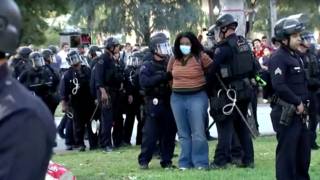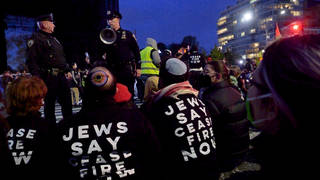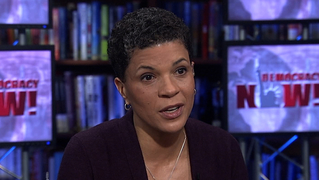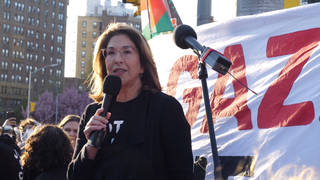
Related
Guests
- Kimberlé Crenshawprofessor of law at UCLA and Columbia University. She is also the founder of the African American Policy Forum and on the board of V-Day.
- Rev. Clinton Stancilsenior pastor of Wayman AME Church in St. Louis.
Just miles away from the scene of the protests in Ferguson lies the grave of Dred Scott at the Calvary Cemetery on West Florissant Avenue. Born a slave in Virginia, Scott sued in a St. Louis court for his freedom. The case went to the Supreme Court, resulting in a landmark 1857 decision that African Americans were not citizens of the United States and therefore had no rights to sue in federal courts. The court described blacks as “beings of an inferior order, and altogether unfit to associate with the white race, either in social or political relations, and so far inferior that they had no rights which the white man was bound to respect.” The Dred Scott Decision is considered by many to be the worst decision in the Supreme Court’s history. We discuss the case’s significance with Kimberlé Crenshaw, professor of law at UCLA and Columbia University and founder of the African American Policy Forum.
Transcript
AMY GOODMAN: Just miles down the road from the scene of protests in Ferguson, we’re hearing a lot about Florissant. Just down Florissant is the grave of Dred Scott, who’s buried in the Calvary Cemetery on West Florissant Avenue. Born a slave in Virginia, Dred Scott sued in a St. Louis court for his freedom. The case went to the Supreme Court, resulting in a landmark Supreme Court decision that’s called the worst ever. In 1857, the court ruled African Americans were not citizens of the United States, and therefore had no rights to sue in federal courts. The court described blacks as, quote, “beings of an inferior order, and altogether unfit to associate with the white race, either in social or political relations, and so far inferior that they had no rights which the white man was bound to respect,” unquote. Again, the Dred Scott decision, considered the worst decision in the history of the Supreme Court, in the slave state of Missouri, the seven-to-two decision. The chief justice was a slave owner himself. In fact, a number of the Supreme Court justices were slave owners themselves.
To talk more about the significance of this case today, we’re joined by Kimberlé Crenshaw, professor of law at UCLA and Columbia University, founder of the African American Policy Forum.
Kimberlé, thank you for joining us. Professor Crenshaw, talk about the significance of Dred Scott’s body just lying down the road on Florissant, the road we’ve heard so much about, as these protests continue and escalate.
KIMBERLÉ CRENSHAW: Well, really couldn’t be more symbolic. As you point out, Dred Scott is widely regarded as being one of the worst cases ever. And there are two ways in which we might see its relevance in this particular moment. One, when the Supreme Court was trying to decide whether African Americans could be citizens, what they considered was the way African Americans were treated. They weren’t necessarily looking at formal law. In a lot of ways, free blacks had more rights than white women did. But the overall idea was that they could be enslavable. The overall idea is that they weren’t seen as having the same social worth as white Americans and could be enslaved for their own good. So the very possibility of their enslavability meant that, at least as far as the founders were concerned, they were going to be forever and permanently a stateless people. And that would have likely been the case had the case not led to a civil war.
But the second thing that is actually equally resonant now is that the Supreme Court was trying to resolve a slavery issue, once and for all, by reinforcing slavery, by saying that if you are a white person and you own a slave, you can do and travel and move anywhere you want with that slave, because the Constitution protects you. So they were trying to end it, in a way that’s quite similar to the way the Supreme Court today is trying to end all agitation around civil rights, trying to end all agitation about integrating police departments. One of the reasons why the Ferguson Police Department looks the way it does is because the Supreme Court has rolled back on anti-discrimination law, rolled back on affirmative action, rolled back on voting rights, and has used the Constitution, the 14th Amendment, in precisely the same way that the Dred Scott case tried to do: to end the whole thing. And that’s why Dred Scott is still relevant now, even though it’s formally overturned.
AMY GOODMAN: And your concerns, Professor Crenshaw, as you look at what’s happening in Ferguson right now?
KIMBERLÉ CRENSHAW: Well, I have concerns in that it seems as though the only thing that really ripped Dred Scott away from history was massive uprising. One was a civil war, and then the next thing that happened was a civil rights movement. What would we think would happen if there was a civil rights movement now with the weapons of mass destruction that local officers have? If we could just imagine what would have happened if Bull Connor had an armored personnel carrier. We might not have had a civil rights movement. And then if we had it, it would have been short-lived. This is why we need the president to be far more aggressive, not just in trying to make both sides happy. No president in a civil rights crisis can make both sides happy. Eisenhower, Nixon, Kennedy, Johnson—they all had to step in very powerfully and say that these are matters that have to be taken up at the federal level, at the legal level. There are specific things that need to be done, and those don’t involve just asking boys to act better or for there to be mentors. There’s only so much you can do holding up your hands against structural and long-term racial problems, that Ferguson has clearly shown. This is the end of post-racialism. The question is, is it the beginning of something else?
AMY GOODMAN: Reverend Stancil, you were recently speaking at a church in Missouri that was founded by freed slaves that was celebrating its something like 150th anniversary. This issue of Dred Scott being buried down the road on Florissant?
REV. CLINTON STANCIL: Well, I think the professor framed that quite well. The Dred Scott decision was a bad decision. But it would have been a bad decision that would have—thank God that it didn’t go unchallenged. And as the professor said, it caused an uprising. And many times, that’s what moved the public debate, was the uprising. And I think this uprising that we’re seeing in Ferguson is what’s going to move the public debate, that we can begin to openly discuss the race. We can begin to openly discuss the lack of diversity, not only in Ferguson, but when we look around in other municipalities throughout the state of Missouri, we see the same thing occurring. And as the professor said, it’s because there has been a cutback, there has been an attack on civil rights, there has been an attack on affirmative action. And now we’re seeing—now we’re beginning to experience—I don’t want to say “see,” experience—the results of it. And so I think the Dred Scott decision is very important. I think it shows great parallel that Dred Scott is buried right down the street from where this uprising is occurring.
AMY GOODMAN: We’re going to have to leave it there. I want to thank Reverend Clinton Stancil, the senior pastor at the Wayman AME Church in St. Louis; Superintendent—former Superintendent Art McCoy of the Ferguson-Florissant School District; Professor Kimberlé Crenshaw, professor of law at UCLA and Columbia University; and Steven Hawkins, executive director of Amnesty International USA.












Media Options